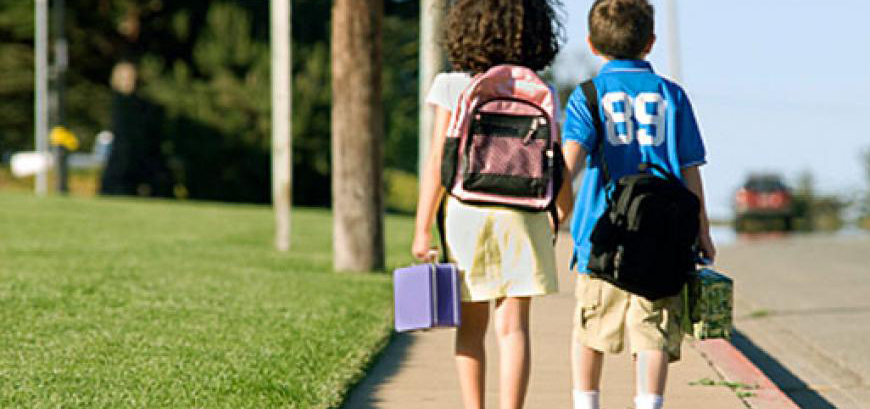
While you may feel your child is old enough to walk to school without having to worry about their safety, think again. Children between ages five and nine haven’t yet developed the skills and experience to judge the speed and distance at which vehicles are moving.
The National Highway Traffic Safety Administration says that one quarter of children between ages five and nine who are killed in traffic crashes are pedestrians. In fact, pedestrian injury is the second-leading cause of injury-related deaths in children of this age group, according to Indiana University Health. Older children are even at risk: more than 25,000 children between ages five and 14 are injured each year while walking, according to the U.S. Centers for Disease Control and Prevention (CDC).
Yet walking to their destination is a great way for kids to get exercise and to help keep cars off the road, too. The solution is to teach your children safe pedestrian skills, while ensuring that they have adult supervision when needed during their commute. Consider the following pointers:
1. Teach the rules of the sidewalk.
While knowing the rules of the road are vital to driving safety, children should learn the rules of the sidewalk for safe walks to and from school. These rules include:
- Crossing the street with an adult until age 10
- Looking to the left, then to the right, and to the left again before crossing
- Learning to use traffic signals and crosswalks properly rather than jaywalking
- Never running out into the street, even to chase a ball or pet
- Always walking on the sidewalk
- Never entering the street between parked cars
- Watching driveways to ensure no cars are backing up
- Making eye contact with drivers when crossing the street
2. Encourage kids to walk in groups.
There’s safety in numbers. Consider partnering your kids up with other kids in the neighborhood who walk the same route. The buddy system can help save lives.
3. Establish emergency contacts.
Ensure that your child knows what to do in case of an emergency—and make sure their walking buddies do too. Establish “safe houses” along the route that children can call on if problems arise. If your child has a cell phone, program emergency numbers in it, such as parents’ work numbers, neighbors’ numbers, and 911, and provide instructions as to how to access each number.
4. Stick to one route.
Stress the importance of sticking to a predetermined route and not deviating by shortcuts or on alternate roads. You can determine the safest route in advance, based on factors such as:
- Fewer street crossings
- More neighbors along the route
- No desolate stretches
5. Organize adult chaperones.
Responsible adults should always accompany kids under 10 on their walk to and from school. Neighbors can trade off the chaperone role to accompany their child as well as others.
6. Provide crossing guards.
Traffic can be particularly heavy near school grounds as cars enter and leave parking lots. If your child’s school has crossing guards, make sure your child knows them. Enforce the importance of crossing at the crosswalk. If your child’s school doesn’t have crossing guards, talk to school administrators or partner with neighbors to ensure adult chaperones help children cross to and from school grounds safely.
7. Partner to enforce speed limits.
If speeding near the school and in your neighborhood is a problem, organize parents to partner with local police to enforce speed limits. The CDC can help with these and other issues through its program KidsWalk-to-School.
While you may feel your child is old enough to walk to school without having to worry about their safety, think again. Children between ages five and nine haven’t yet developed the skills and experience to judge the speed and distance at which vehicles are moving.
The National Highway Traffic Safety Administration says that one quarter of children between ages five and nine who are killed in traffic crashes are pedestrians. In fact, pedestrian injury is the second-leading cause of injury-related deaths in children of this age group, according to Indiana University Health. Older children are even at risk: more than 25,000 children between ages five and 14 are injured each year while walking, according to the U.S. Centers for Disease Control and Prevention (CDC).
Yet walking to their destination is a great way for kids to get exercise and to help keep cars off the road, too. The solution is to teach your children safe pedestrian skills, while ensuring that they have adult supervision when needed during their commute. Consider the following pointers:
1. Teach the rules of the sidewalk.
While knowing the rules of the road are vital to driving safety, children should learn the rules of the sidewalk for safe walks to and from school. These rules include:
- Crossing the street with an adult until age 10
- Looking to the left, then to the right, and to the left again before crossing
- Learning to use traffic signals and crosswalks properly rather than jaywalking
- Never running out into the street, even to chase a ball or pet
- Always walking on the sidewalk
- Never entering the street between parked cars
- Watching driveways to ensure no cars are backing up
- Making eye contact with drivers when crossing the street
2. Encourage kids to walk in groups.
There’s safety in numbers. Consider partnering your kids up with other kids in the neighborhood who walk the same route. The buddy system can help save lives.
3. Establish emergency contacts.
Ensure that your child knows what to do in case of an emergency—and make sure their walking buddies do too. Establish “safe houses” along the route that children can call on if problems arise. If your child has a cell phone, program emergency numbers in it, such as parents’ work numbers, neighbors’ numbers, and 911, and provide instructions as to how to access each number.
4. Stick to one route.
Stress the importance of sticking to a predetermined route and not deviating by shortcuts or on alternate roads. You can determine the safest route in advance, based on factors such as:
- Fewer street crossings
- More neighbors along the route
- No desolate stretches
5. Organize adult chaperones.
Responsible adults should always accompany kids under 10 on their walk to and from school. Neighbors can trade off the chaperone role to accompany their child as well as others.
6. Provide crossing guards.
Traffic can be particularly heavy near school grounds as cars enter and leave parking lots. If your child’s school has crossing guards, make sure your child knows them. Enforce the importance of crossing at the crosswalk. If your child’s school doesn’t have crossing guards, talk to school administrators or partner with neighbors to ensure adult chaperones help children cross to and from school grounds safely.
7. Partner to enforce speed limits.
If speeding near the school and in your neighborhood is a problem, organize parents to partner with local police to enforce speed limits. The CDC can help with these and other issues through its program KidsWalk-to-School.
